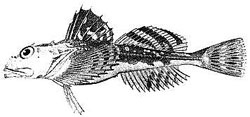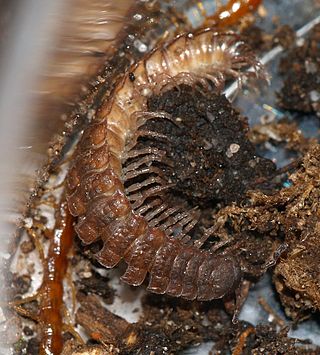
A sculpin is a type of fish that belongs to the superfamily Cottoidea in the order Scorpaeniformes. As of 2006, this superfamily contains 7 families, 94 genera, and 387 species.

The pale toadfish is a fathead sculpin of the family Psychrolutidae, found on the continental shelf around New Zealand, between 250 and 1,000 metres deep. It is up to 30 cm long.

Gladiolus angustus is a species of gladiolus known by the common name long-tubed painted lady. It is native to the Cape Provinces of South Africa.
Ditylenchus angustus is a plant pathogenic nematode.
Hippocampus angustus, commonly known as the narrow-bellied seahorse, western Australian seahorse, or western spiny seahorse, is a species of marine fish of the family Syngnathidae. It is found in waters off of Australia, from Perth to Hervey Bay, and the southern portion of Papua New Guinea in the Torres Strait. It lives over soft-bottom substrates, adjacent to coral reefs, and on soft corals at depths of 3–63 metres (9.8–206.7 ft). It is expected to feed on small crustaceans, similar to other seahorses. This species is ovoviviparous, with males carrying eggs in a brood pouch before giving birth to live young. This type of seahorse is monogamous in its mating patterns. The males only fertilize one female's eggs for the mating season because of the population distribution. While some seahorses can be polygamous because they are denser in population, this type of seahorse is more sparsely distributed and the cost of reproduction is high. Therefore, the risk to reproduce due to predatory and distributary factors limits this breed to one mate, often finding the same mate season after season.

Anaethalion is an extinct genus of prehistoric ray-finned fish.

Polydesmus angustus, also known as the flat-backed millipede, is a millipede in the genus Polydesmus.

Angustus Labyrinthus is a complex of intersecting valleys or ridges near the Martian south pole, located at 81.68° S and 63.25° W. It was nicknamed the "Inca City" by NASA scientists due to its superficial resemblance to a ruined city. Like other formations in the area, the name 'Angustus' derives from a name given by Eugene Antoniadi in 1930 to an albedo feature that corresponds with the area. The name was approved in 2006.
Poropuntius angustus is a species of cyprinid fish. It is endemic to the Mekong Basin and is currently only known from a few tributaries of Mekong in Laos. It grows to 12 cm (4.7 in) SL. It lives mainly in small forest streams.
The Santa Cruz Island sator is a species of phrynosomatid lizard found on Santa Cruz Island, in the Gulf of California, Baja California, Mexico. S. angustus seems to be found throughout both islands of Santa Cruz, exploiting a great variety of temperate habitats, such as rocky areas, caves along beaches, areas of beach cobblestones, and sandy substrates, with animals also seen on the branches of small bushes and the limbs of cardones (cacti).
Zandvlei Estuary Nature Reserve is a 300-hectare (740-acre) nature reserve and recreational area located in Muizenberg near Cape Town, South Africa.

Leymus angustus is a species of grass known by the common name Altai wildrye. It is native to Asia and Europe and it is cultivated elsewhere as a pasture grass, especially in Canada.
Copelatus angustus is a species of diving beetle. It is part of the genus Copelatus in the subfamily Copelatinae of the family Dytiscidae. It was described by Gschwendtner in 1932.
Orthogonius angustus is a species of ground beetle in the subfamily Orthogoniinae. It was described by Maximilien Chaudoir in 1871.
Pseudotaxalus is a genus of longhorn beetles of the subfamily Lamiinae, containing the following species:
Pseudotaxalus alboguttatus is a species of beetle in the family Cerambycidae. It was described by Stephan von Breuning in 1939.

Lichenophanes angustus is a species of horned powder-post beetle in the family Bostrichidae. It is found in North America.
Stenus angustus is a species of water skater in the beetle family Staphylinidae. It is found in North America.
Eremobates angustus is a species of windscorpion in the family Eremobatidae.

Ixodes angustus is a species of parasitic tick, whose range encompasses the majority of Canada and the United States, along with parts of northern Mexico. I. angustus is a member of the Ixodidae (hard-bodied) family of ticks. It is most abundant in cool, moist biomes such as riparian, boreal or montane zones. I. angustus is a host generalist and has been discovered feeding on more than 90 different host species, including humans and domestic dogs. I. angustus has been identified as a potential vector for Lyme disease but is not considered a principle vector due to the relative rarity with which it feeds on humans.








